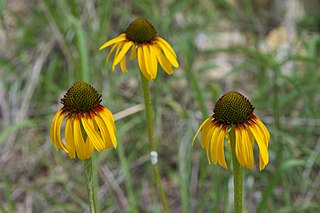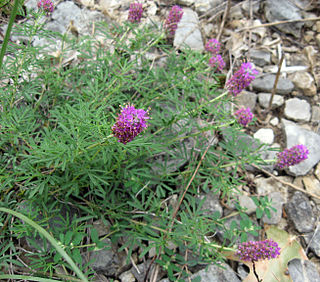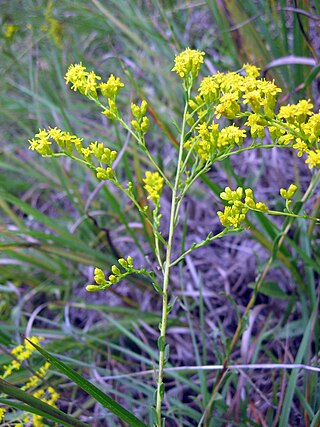
Echinacea is a genus of herbaceous flowering plants in the daisy family. It has ten species, which are commonly called coneflowers. They are found only in eastern and central North America, where they grow in moist to dry prairies and open wooded areas. They have large, showy heads of composite flowers, blooming in summer. The generic name is derived from the Greek word ἐχῖνος, meaning "sea urchin", due to the spiny central disk. These flowering plants and their parts have different uses. Some species are cultivated in gardens for their showy flowers. Two of the species, E. tennesseensis and E. laevigata, are listed in the United States as endangered species.
The Nashville Basin, also known as the Central Basin, is a term often used to describe the area surrounding Murfreesboro, Tennessee, in which Nashville is located. The Central Basin was caused by an uplifting which produced a dome known as the Nashville Dome. The Nashville Dome is evidenced by the underlying rock strata that all dip downwards away from Nashville. The uplifting of the Nashville Dome fractured overlying strata, making it more easily eroded and thus the "dome" resulted in a "basin". Uplifted strata in the center of a geological dome have higher potential erosive energy than the surrounding strata, because they are physically higher. Erosion thus acts on the uplifted area at a greater rate than on the surrounding flat-lying area, creating a low area, i.e. a basin. This area is more correctly referred to as the "Central Dome" of Tennessee.

Echinacea tennesseensis, also known as the Tennessee coneflower or Tennessee purple coneflower, is a flowering plant in the family Asteraceae, endemic to the cedar glades of the central portion of the U.S. state of Tennessee.

Astragalus bibullatus, the limestone glade milkvetch or Pyne's ground plum, is an endangered species of flowering plant that is endemic to the cedar glades of the central basin of Tennessee in the United States. It is found in only eight populations located within a few kilometers of each other in Rutherford County, Tennessee.

Eriogonum longifolium var. harperi, also known as Harper's buckwheat or Harper's umbrella plant, is a dicot of the family Polygonaceae, found in areas of nutrient-poor shale soils in Alabama, Kentucky and Tennessee. It lives inconspicuously in an immature vegetative stage for four or more years before developing a flowering stalk, then flowers and dies. It is listed as an endangered species by the state of Tennessee. It has eleven small populations in Alabama and five in Tennessee but its survival in Kentucky is uncertain. According to a leading expert, Professor James L. Reveal of the University of Maryland, its Kentucky population has been reportedly extirpated. Its 2006 Alabama Natural Heritage Program ranking was G4T2S1, demonstrating an opinion that it was "critically imperiled" in that state.

Echinacea simulata, commonly called wavy leaf purple coneflower, glade coneflower, or prairie purple coneflower, is a species of perennial flowering plant in the family Asteraceae. It is native to the east-central states of the United States. Its natural habitat is dry, calcareous, open areas such as barrens and woodlands.

Echinacea paradoxa, the yellow coneflower, Bush's purple coneflower, or Ozark coneflower, is a North American species of flowering plant in the family Asteraceae. It is native to southern Missouri, Arkansas, and south-central Oklahoma, It is listed as threatened in Arkansas.

Elsie Quarterman was a prominent plant ecologist. She was a Professor Emerita at Vanderbilt University.

Cedars of Lebanon State Park is a state park in Wilson County, Tennessee, in the southeastern United States. It consists of 900 acres (364 ha) situated amidst the 9,420-acre (3,810 ha) Cedars of Lebanon State Forest. The park and forest are approximately 10 miles (16 km) south of Lebanon, Tennessee.

Dalea foliosa, commonly called leafy prairie clover, is a species of flowering plant in the legume family (Fabaceae). It is an endangered species in the United States, where it occurs in three states: Illinois, Tennessee, and Alabama.
Paysonia perforata, known by the common name Spring Creek bladderpod, is a rare species of flowering plant in the mustard family. It is endemic to Tennessee in the United States, where it is known only from Wilson County. This very rare plant is threatened by the loss and degradation of its habitat. It is federally listed as an endangered species.

Astragalus tennesseensis is a species of flowering plant in the legume family known by the common name Tennessee milkvetch. It is native to the United States, where it is known from Illinois, Indiana, Tennessee and Alabama. Most of the occurrences are in Tennessee.

The Interior Low Plateaus are a physiographic region in eastern United States. It consists of a diverse landscape that extends from north Alabama across central Tennessee and Kentucky into southern Illinois, Indiana, and Ohio. Its natural communities are a matrix of temperate forests, woodlands, and prairies.

Pediomelum subacaule is a species of flowering plant in the legume family known by the common names Nashville breadroot and whiterim scurfpea. It is native to a small area of Eastern North America, only being found in limestone cedar glades of the Interior Low Plateau and Ridge and Valley ecoregions of Alabama, Georgia, and Tennessee.
Leavenworthia crassa is a species of flowering plant in the mustard family, Brassicaceae, known commonly as the fleshy-fruit gladecress. It is endemic to Alabama in the United States, where it occurs in only two counties. It is "likely one of the most imperiled plant species in the Southeast," and the United States Fish and Wildlife Service issued a final rule listing it as an endangered species in 2014.

Dalea gattingeri, commonly called purpletassles or Gattinger prairie clover, is a species of flowering plant in the legume family. It is native to the Southeastern United States, where it is restricted to limestone cedar glades of Tennessee, Alabama, Georgia, Missouri, and Arkansas. Its populations are widely dispersed and geographically small, with most populations being found in the Nashville Basin.

Solidago gattingeri, common name Gattinger's goldenrod, is a species of plant that is a goldenrod. It is native only to the Ozark Mountains of Arkansas and Missouri and to the Nashville Basin of Tennessee. Its preferred habitat is cedar glades, cedar barrens, and limestone outcrops. It is adapted to dry habitats.

Lithospermum molle, the softhair marbleseed, is a species of flowering plant in the forget-me-not family. This species is a narrow endemic, native primarily to the Nashville Basin of Tennessee, where it is found in limestone prairies near cedar glades. There are disjunct populations in similar habitats in the Ozark Mountains of Missouri, in northwest Alabama, in Logan and Warren County, Kentucky as well as other small areas of Tennessee. Outside of Tennessee, it is very rare and perhaps no longer exists in Alabama and Kentucky due to habitat destruction. Because of its highly restricted geographic range, this species is considered vulnerable.

Leavenworthia torulosa, the necklace gladecress, is a species of plant in the mustard family. It is native to the eastern United States where it is only found near limestone cedar glades of Alabama, Georgia, Kentucky, and Tennessee. It is considered rare in all states it is found except Tennessee, where it is common in the Nashville Basin due to the abundance of available habitat.

Couchville Cedar Glade State Natural Area is a Class II Natural-Scientific state natural area located in Davidson and Wilson counties Tennessee. Its western boundary is contiguous with the eastern boundary of Long Hunter State Park. The park's name reflects its location near the now extinct inundated community of Couchville, Tennessee.

















